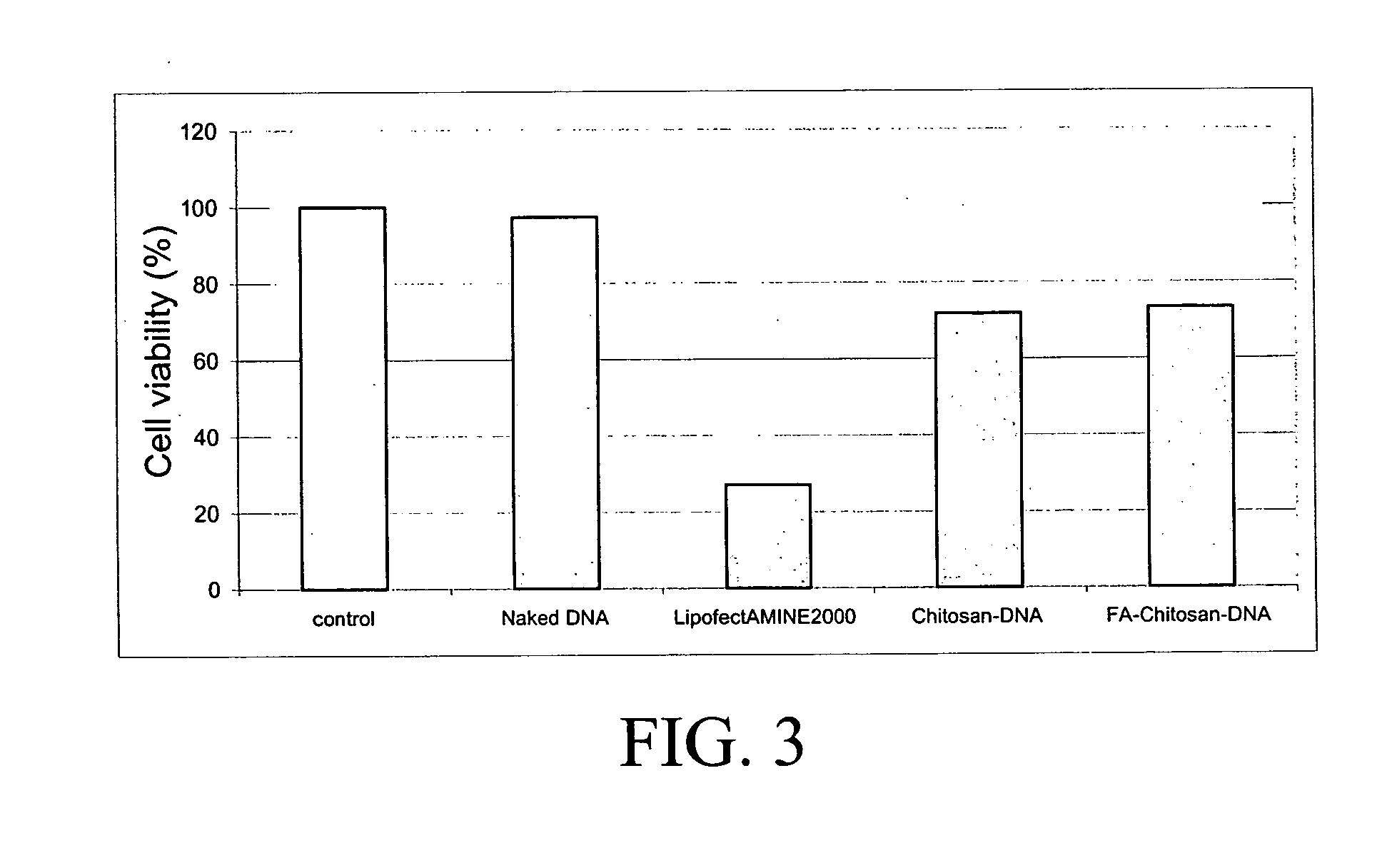Folic acid-chitosan-DNA nanoparticles
- Summary
- Abstract
- Description
- Claims
- Application Information
AI Technical Summary
Benefits of technology
Problems solved by technology
Method used
Image
Examples
example 1
Synthesis of Folic Acid-Chitosan Conjugate.
[0024] A solution of 500 mg of 1-(3-dimethylaminopropyl)-3-ethylcarbodiimide hydrochloride (EDC) and 500 mg of folic acid (Sigma-Aldrich, St. Louis, Mo., USA) in 12 ml of anhydrous dimethylsulfoxide (DMSO) (Sigma) is prepared and stirred for 1 hour at room temperature until the folic acid is dissolved. The folic acid preparation is added to a solution of 0.1% (w / v) chitosan (MW: 150 kDa, 85% degree of deacetylation obtained from Fluka Biokemica, Buchs, Switzerland) in acetate buffer (pH 4.7) and stirred, in the dark, for 16 hours at room temperature. The pH of the solution is brought to 9.0 by dropwise addition of diluted aqueous NaOH. The resulting mixture is dialyzed for a period of 3 days against phosphate buffer at pH 7.4 and 3 days against water. The resulting folic acid-chitosan polymer is then isolated by lyophilization. The reaction scheme and resulting polymer are illustrated in FIG. 1.
[0025] A preferred folic acid-chitosan conj...
example 2
1. Preparation of DNA Plasmid.
[0027] The VR1412 DNA plasmid (VICAL Inc., San Diego, Calif., USA) was purified using the Qiagen QIAfilter plasmid Giga kit (Mississauga, ON, Canada) according to the manufacturer's instructions and resuspended in water. The integrity of DNA plasmid was analyzed on a 0.8% agarose gel and DNA concentration was measured by UV absorbance at 260 nm (Corsi, K. et al., 2003, Biomaterials 24: 1255-1264).
2. Synthesis of Folic Acid-Chitosan-DNA Nanoparticles.
[0028] a) The folic acid-chitosan conjugate of Example 1 was dissolved in 20 mM acetic acid at pH 5.5 under low heating (inferior to 45° C.). The solution was then adjusted to a final concentration of 0.01% chitosan in 5 mM acetic acetate and sterile filtered through a 0.22 μm filter. The DNA plasmid solution was diluted in a 4.3 mM sodium sulfate solution to a concentration of 200 mg / ml. The folic acid-chitosan-DNA complex formation was achieved by a coacervation technique as described by Mao et al. (2...
PUM
| Property | Measurement | Unit |
|---|---|---|
| Size | aaaaa | aaaaa |
| Size | aaaaa | aaaaa |
| Ratio | aaaaa | aaaaa |
Abstract
Description
Claims
Application Information
 Login to View More
Login to View More - R&D
- Intellectual Property
- Life Sciences
- Materials
- Tech Scout
- Unparalleled Data Quality
- Higher Quality Content
- 60% Fewer Hallucinations
Browse by: Latest US Patents, China's latest patents, Technical Efficacy Thesaurus, Application Domain, Technology Topic, Popular Technical Reports.
© 2025 PatSnap. All rights reserved.Legal|Privacy policy|Modern Slavery Act Transparency Statement|Sitemap|About US| Contact US: help@patsnap.com



